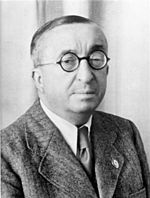Ernst Heinkel
| Dr. Ernst Heinkel | |
|---|---|
 |
|
| Born |
January 24, 1888 Grunbach, German Empire |
| Died | January 30, 1958 (aged 70) Stuttgart, West Germany |
| Occupation | German aircraft designer and manufacturer |
| Awards | German National Prize for Art and Science (1938) |
Dr. Ernst Heinkel (January 24, 1888 – January 30, 1958) was a German aircraft designer, manufacturer, Wehrwirtschaftsführer in the Third Reich, and member of the Nazi party. His company Heinkel Flugzeugwerke produced the Heinkel He 178, the world's first turbojet aircraft and jet plane, and the Heinkel He 176, the first rocket aircraft. He was awarded the German National Prize for Art and Science in 1938.
He was born in Grunbach, today a part of Remshalden. As a young man he became an apprentice machinist at a foundry. Heinkel studied at the Technical Academy of Stuttgart, where he initially became interested in aviation through a fascination with Zeppelins, and in 1909 attended an international airshow in Frankfurt am Main. He determined flight was the future of transportation, and the following year, he built his first aircraft, working from a set of plans by Henri Farman. Heinkel crashed the plane in 1911 and suffered severe injuries.
Soon afterwards, he gained employment at Luft-Verkehrs Gesellschaft (LVG), who were building Farman aircraft. From there, he went to Albatros. Heinkel claimed post-war to have designed the Albatros B.II, a successful reconnaissance and trainer aircraft used during the early stages of the First World War, but its main designer was in fact Robert Thelen. His planes were used by the Austro-Hungarian army and Germany's Kaiserliche Marine during the war. After leaving the Albatros, Heinkel designed several land- and seaplanes for the Hansa-Brandenburg company starting in 1914.
...
Wikipedia
